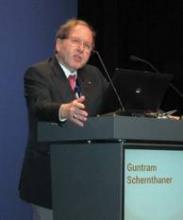User login
BERLIN – Treatment of type 2 diabetes patients with canagliflozin, an investigational drug that boosts urinary glucose excretion, produced a clear rise in glycemic control while also dropping blood pressure and weight, compared with the established agent sitagliptin, in a phase III study with 755 patients.
"This is a very nice tool to reduce hemoglobin A1c, blood pressure, and weight all together with relatively nice results," Dr. Guntram Schernthaner said at the annual meeting of the European Association for the Study of Diabetes.
The major apparent downside of canagliflozin, an inhibitor of the sodium glucose cotransporter 2 (SGLT2), was its association with a 15% rate of genital mycotic infections in women and a 9% rate in men, compared with rates of 4% in women and less than 1% in men in the comparator arm.
The benefits from canagliflozin were "impressive. It looks real," commented Dr. Bernard Zinman, director of the Center for Diabetes at Mount Sinai Hospital in Toronto.
It’s currently unclear whether the significant blood pressure and weight loss effects of the drug plus its antihyperglycemic effect will cut cardiovascular events. That’s under study, he noted, and will be a key to whether canagliflozin and other drugs in its class become major players for treating patients with diabetes. Dr. Zinman also wondered how the genital infection problem will play out for these drugs. "That will be an issue. Physicians may stay away from using it on women if one in six gets an infection," he said in an interview.
The phase III comparison between canagliflozin and sitagliptin reported by Dr. Schernthaner was one of several reports on phase III studies released during the past few months by Janssen, the company developing canagliflozin. Last May, Janssen submitted a marketing approval application to the Food and Drug Administration for the drug.
Canagliflozin is one of several SGLT2 inhibitors now under development for diabetes. They boost the amount of glucose entering urine, and also inhibit intestinal glucose absorption. Dapagliflozin, another drug from the class, also has FDA approval pending, while empagliflozin is now in several phase III studies.
Dr. Schernthaner’s findings came from 755 patients with type 2 diabetes who remained poorly controlled despite stable treatment with metformin and a sulfonylurea. Patients had an average age of 57 years, they had type 2 diabetes for an average of 10 years, their average hemoglobin A1c was 8.1%, and their average fasting plasma glucose was 9.2 mmol/L. The researchers randomized 378 patients to receive 100 mg sitagliptin daily and 377 to received 300 mg canagliflozin daily.
After 52 weeks, hemoglobin A1c fell an average 1.03% compared with baseline in the canagliflozin arm and 0.66% in the sitagliptin group, a statistically significant difference for the study’s primary end point, reported Dr. Schernthaner, a professor at Rudolfstiftung Hospital in Vienna.
Other statistically significant between-group differences included the drop in fasting plasma glucose, 1.7 mmol/L with canagliflozin and 0.3 mmol/L with sitagliptin, the change in body weight, an average 2.3 kg drop with canagliflozin and a 0.1 kg rise with sitagliptin, and blood pressure change, a fall of 5.3 mm Hg with canagliflozin and a +0.9/–0.3 change with sitagliptin.
Rates of adverse events, including serious adverse events leading to withdrawal from the study, and hypoglycemic episodes, were similar in the two treatment arms, with the only substantial difference being the excess genital mycotic infections with canagliflozin.
"The interesting question is how would an SGLT2 inhibitor act when given along with a dipeptidyl peptidase-4 inhibitor" like sitagliptin, commented Dr. Baptist J. Gallwitz, professor of diabetology and endocrinology at Tubingen University Hospital in Germany. "The SGLT-2 inhibitor drugs will be an important class because they have a distinct, independent mode of action. You can theoretically combine them with any other drug and use them at any stage of diabetes," he said in an interview.
One troubling feature of the new canagliflozin study was the high rate of patients who dropped out, 44% of those in the sitagliptin arm and 33% in the canagliflozin group. Many of the dropouts occurred when patients failed to meet prespecified glycemic targets – 23% of patients in the sitagliptin arm and 11% put on canagliflozin.
"You need to be cautious. The tremendous dropout rate is not acceptable," said Dr. Zinman. "It’s very difficult to interpret a study with that kind of dropout."
Another possible flaw in the study was using sitagliptin as the comparator on top of background treatment with another secretagogue, a sulfonylurea. It’s possible that "patients were already getting the maximum benefit from the sulfonylurea" and so couldn’t show much additional benefit from also receiving canagliflozin, Dr. Zinman said.
The study was sponsored by Janssen, the company developing canagliflozin. Dr. Schernthaner said that he has received honoraria and research funding from Janssen, AstraZeneca and Bristol-Myers Squibb, the companies developing dapagliflozin, and from Boehringer Ingelheim, the company developing empagliflozin. Dr. Zinman said that he has received honoraria and research funding from Johnson & Johnson (the parent company of Janssen), and Boehringer Ingelheim and other drug companies. Dr. Gallwitz said that he has received honoraria and research funding from Boehringer Ingelheim, AstraZeneca and Bristol-Myers Squibb, and other drug companies.
Dr. Bernard Zinman, Janssen
BERLIN – Treatment of type 2 diabetes patients with canagliflozin, an investigational drug that boosts urinary glucose excretion, produced a clear rise in glycemic control while also dropping blood pressure and weight, compared with the established agent sitagliptin, in a phase III study with 755 patients.
"This is a very nice tool to reduce hemoglobin A1c, blood pressure, and weight all together with relatively nice results," Dr. Guntram Schernthaner said at the annual meeting of the European Association for the Study of Diabetes.
The major apparent downside of canagliflozin, an inhibitor of the sodium glucose cotransporter 2 (SGLT2), was its association with a 15% rate of genital mycotic infections in women and a 9% rate in men, compared with rates of 4% in women and less than 1% in men in the comparator arm.
The benefits from canagliflozin were "impressive. It looks real," commented Dr. Bernard Zinman, director of the Center for Diabetes at Mount Sinai Hospital in Toronto.
It’s currently unclear whether the significant blood pressure and weight loss effects of the drug plus its antihyperglycemic effect will cut cardiovascular events. That’s under study, he noted, and will be a key to whether canagliflozin and other drugs in its class become major players for treating patients with diabetes. Dr. Zinman also wondered how the genital infection problem will play out for these drugs. "That will be an issue. Physicians may stay away from using it on women if one in six gets an infection," he said in an interview.
The phase III comparison between canagliflozin and sitagliptin reported by Dr. Schernthaner was one of several reports on phase III studies released during the past few months by Janssen, the company developing canagliflozin. Last May, Janssen submitted a marketing approval application to the Food and Drug Administration for the drug.
Canagliflozin is one of several SGLT2 inhibitors now under development for diabetes. They boost the amount of glucose entering urine, and also inhibit intestinal glucose absorption. Dapagliflozin, another drug from the class, also has FDA approval pending, while empagliflozin is now in several phase III studies.
Dr. Schernthaner’s findings came from 755 patients with type 2 diabetes who remained poorly controlled despite stable treatment with metformin and a sulfonylurea. Patients had an average age of 57 years, they had type 2 diabetes for an average of 10 years, their average hemoglobin A1c was 8.1%, and their average fasting plasma glucose was 9.2 mmol/L. The researchers randomized 378 patients to receive 100 mg sitagliptin daily and 377 to received 300 mg canagliflozin daily.
After 52 weeks, hemoglobin A1c fell an average 1.03% compared with baseline in the canagliflozin arm and 0.66% in the sitagliptin group, a statistically significant difference for the study’s primary end point, reported Dr. Schernthaner, a professor at Rudolfstiftung Hospital in Vienna.
Other statistically significant between-group differences included the drop in fasting plasma glucose, 1.7 mmol/L with canagliflozin and 0.3 mmol/L with sitagliptin, the change in body weight, an average 2.3 kg drop with canagliflozin and a 0.1 kg rise with sitagliptin, and blood pressure change, a fall of 5.3 mm Hg with canagliflozin and a +0.9/–0.3 change with sitagliptin.
Rates of adverse events, including serious adverse events leading to withdrawal from the study, and hypoglycemic episodes, were similar in the two treatment arms, with the only substantial difference being the excess genital mycotic infections with canagliflozin.
"The interesting question is how would an SGLT2 inhibitor act when given along with a dipeptidyl peptidase-4 inhibitor" like sitagliptin, commented Dr. Baptist J. Gallwitz, professor of diabetology and endocrinology at Tubingen University Hospital in Germany. "The SGLT-2 inhibitor drugs will be an important class because they have a distinct, independent mode of action. You can theoretically combine them with any other drug and use them at any stage of diabetes," he said in an interview.
One troubling feature of the new canagliflozin study was the high rate of patients who dropped out, 44% of those in the sitagliptin arm and 33% in the canagliflozin group. Many of the dropouts occurred when patients failed to meet prespecified glycemic targets – 23% of patients in the sitagliptin arm and 11% put on canagliflozin.
"You need to be cautious. The tremendous dropout rate is not acceptable," said Dr. Zinman. "It’s very difficult to interpret a study with that kind of dropout."
Another possible flaw in the study was using sitagliptin as the comparator on top of background treatment with another secretagogue, a sulfonylurea. It’s possible that "patients were already getting the maximum benefit from the sulfonylurea" and so couldn’t show much additional benefit from also receiving canagliflozin, Dr. Zinman said.
The study was sponsored by Janssen, the company developing canagliflozin. Dr. Schernthaner said that he has received honoraria and research funding from Janssen, AstraZeneca and Bristol-Myers Squibb, the companies developing dapagliflozin, and from Boehringer Ingelheim, the company developing empagliflozin. Dr. Zinman said that he has received honoraria and research funding from Johnson & Johnson (the parent company of Janssen), and Boehringer Ingelheim and other drug companies. Dr. Gallwitz said that he has received honoraria and research funding from Boehringer Ingelheim, AstraZeneca and Bristol-Myers Squibb, and other drug companies.
BERLIN – Treatment of type 2 diabetes patients with canagliflozin, an investigational drug that boosts urinary glucose excretion, produced a clear rise in glycemic control while also dropping blood pressure and weight, compared with the established agent sitagliptin, in a phase III study with 755 patients.
"This is a very nice tool to reduce hemoglobin A1c, blood pressure, and weight all together with relatively nice results," Dr. Guntram Schernthaner said at the annual meeting of the European Association for the Study of Diabetes.
The major apparent downside of canagliflozin, an inhibitor of the sodium glucose cotransporter 2 (SGLT2), was its association with a 15% rate of genital mycotic infections in women and a 9% rate in men, compared with rates of 4% in women and less than 1% in men in the comparator arm.
The benefits from canagliflozin were "impressive. It looks real," commented Dr. Bernard Zinman, director of the Center for Diabetes at Mount Sinai Hospital in Toronto.
It’s currently unclear whether the significant blood pressure and weight loss effects of the drug plus its antihyperglycemic effect will cut cardiovascular events. That’s under study, he noted, and will be a key to whether canagliflozin and other drugs in its class become major players for treating patients with diabetes. Dr. Zinman also wondered how the genital infection problem will play out for these drugs. "That will be an issue. Physicians may stay away from using it on women if one in six gets an infection," he said in an interview.
The phase III comparison between canagliflozin and sitagliptin reported by Dr. Schernthaner was one of several reports on phase III studies released during the past few months by Janssen, the company developing canagliflozin. Last May, Janssen submitted a marketing approval application to the Food and Drug Administration for the drug.
Canagliflozin is one of several SGLT2 inhibitors now under development for diabetes. They boost the amount of glucose entering urine, and also inhibit intestinal glucose absorption. Dapagliflozin, another drug from the class, also has FDA approval pending, while empagliflozin is now in several phase III studies.
Dr. Schernthaner’s findings came from 755 patients with type 2 diabetes who remained poorly controlled despite stable treatment with metformin and a sulfonylurea. Patients had an average age of 57 years, they had type 2 diabetes for an average of 10 years, their average hemoglobin A1c was 8.1%, and their average fasting plasma glucose was 9.2 mmol/L. The researchers randomized 378 patients to receive 100 mg sitagliptin daily and 377 to received 300 mg canagliflozin daily.
After 52 weeks, hemoglobin A1c fell an average 1.03% compared with baseline in the canagliflozin arm and 0.66% in the sitagliptin group, a statistically significant difference for the study’s primary end point, reported Dr. Schernthaner, a professor at Rudolfstiftung Hospital in Vienna.
Other statistically significant between-group differences included the drop in fasting plasma glucose, 1.7 mmol/L with canagliflozin and 0.3 mmol/L with sitagliptin, the change in body weight, an average 2.3 kg drop with canagliflozin and a 0.1 kg rise with sitagliptin, and blood pressure change, a fall of 5.3 mm Hg with canagliflozin and a +0.9/–0.3 change with sitagliptin.
Rates of adverse events, including serious adverse events leading to withdrawal from the study, and hypoglycemic episodes, were similar in the two treatment arms, with the only substantial difference being the excess genital mycotic infections with canagliflozin.
"The interesting question is how would an SGLT2 inhibitor act when given along with a dipeptidyl peptidase-4 inhibitor" like sitagliptin, commented Dr. Baptist J. Gallwitz, professor of diabetology and endocrinology at Tubingen University Hospital in Germany. "The SGLT-2 inhibitor drugs will be an important class because they have a distinct, independent mode of action. You can theoretically combine them with any other drug and use them at any stage of diabetes," he said in an interview.
One troubling feature of the new canagliflozin study was the high rate of patients who dropped out, 44% of those in the sitagliptin arm and 33% in the canagliflozin group. Many of the dropouts occurred when patients failed to meet prespecified glycemic targets – 23% of patients in the sitagliptin arm and 11% put on canagliflozin.
"You need to be cautious. The tremendous dropout rate is not acceptable," said Dr. Zinman. "It’s very difficult to interpret a study with that kind of dropout."
Another possible flaw in the study was using sitagliptin as the comparator on top of background treatment with another secretagogue, a sulfonylurea. It’s possible that "patients were already getting the maximum benefit from the sulfonylurea" and so couldn’t show much additional benefit from also receiving canagliflozin, Dr. Zinman said.
The study was sponsored by Janssen, the company developing canagliflozin. Dr. Schernthaner said that he has received honoraria and research funding from Janssen, AstraZeneca and Bristol-Myers Squibb, the companies developing dapagliflozin, and from Boehringer Ingelheim, the company developing empagliflozin. Dr. Zinman said that he has received honoraria and research funding from Johnson & Johnson (the parent company of Janssen), and Boehringer Ingelheim and other drug companies. Dr. Gallwitz said that he has received honoraria and research funding from Boehringer Ingelheim, AstraZeneca and Bristol-Myers Squibb, and other drug companies.
Dr. Bernard Zinman, Janssen
Dr. Bernard Zinman, Janssen
AT THE ANNUAL MEETING OF THE EUROPEAN ASSOCIATION FOR THE STUDY OF DIABETES
Major Finding: Treatment with canagliflozin produced a 1% drop in hemoglobin A1c, compared with a 0.66% cut by sitagliptin.
Data Source: A multicenter, randomized study that compared canagliflozin and sitagliptin in 755 patients with type 2 diabetes.
Disclosures: The study was sponsored by Janssen, the company developing canagliflozin. Dr. Schernthaner said that he has received honoraria and research funding from Janssen, AstraZeneca and Bristol-Myers Squibb, the companies developing dapagliflozin, and from Boehringer Ingelheim, the company developing empagliflozin. Dr. Zinman said that he has received honoraria and research funding from Johnson & Johnson, Boehringer Ingelheim, and other drug companies. Dr. Gallwitz said that he has received honoraria and research funding from Boehringer Ingelheim, AstraZeneca and Bristol-Myers Squibb, and other drug companies.


